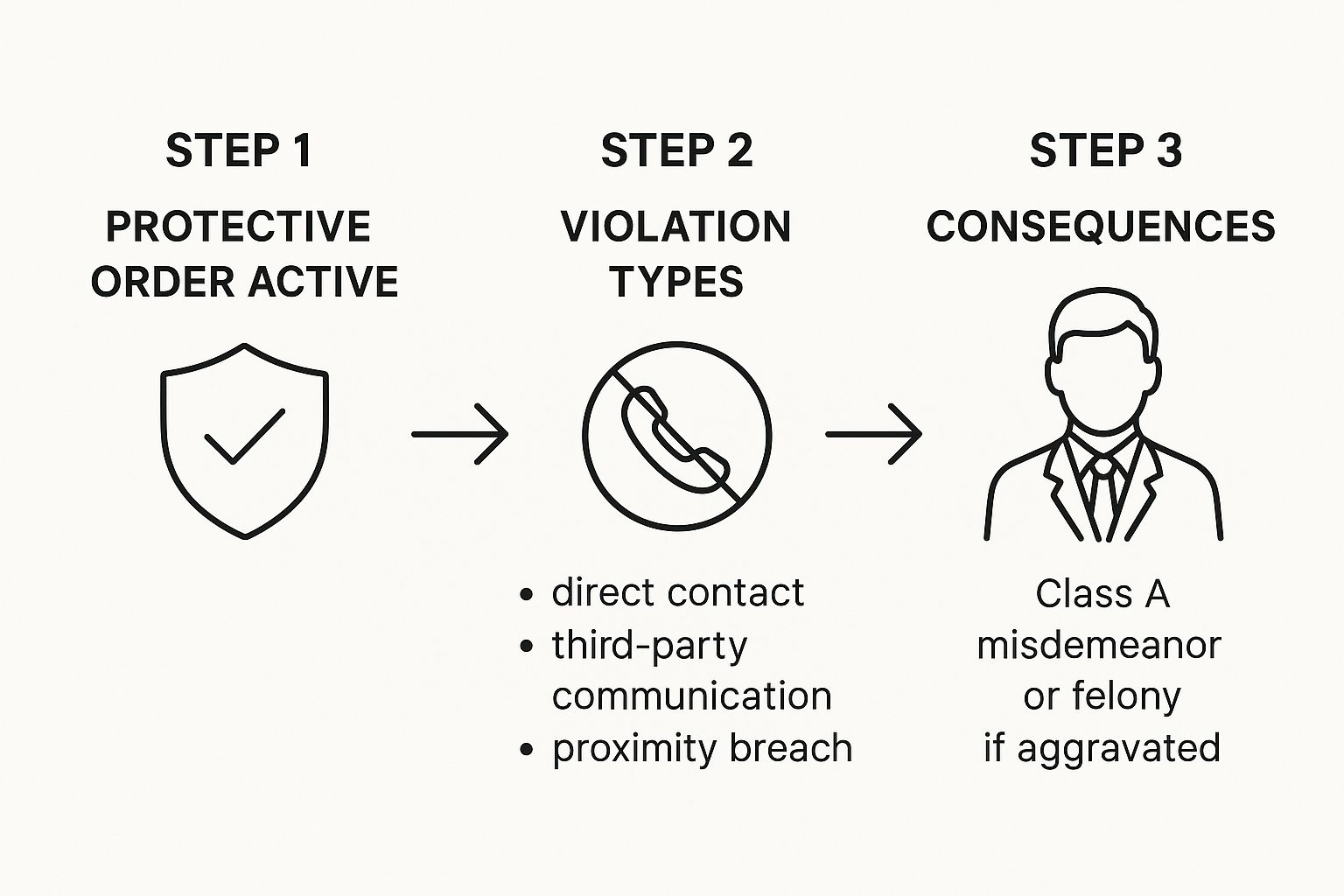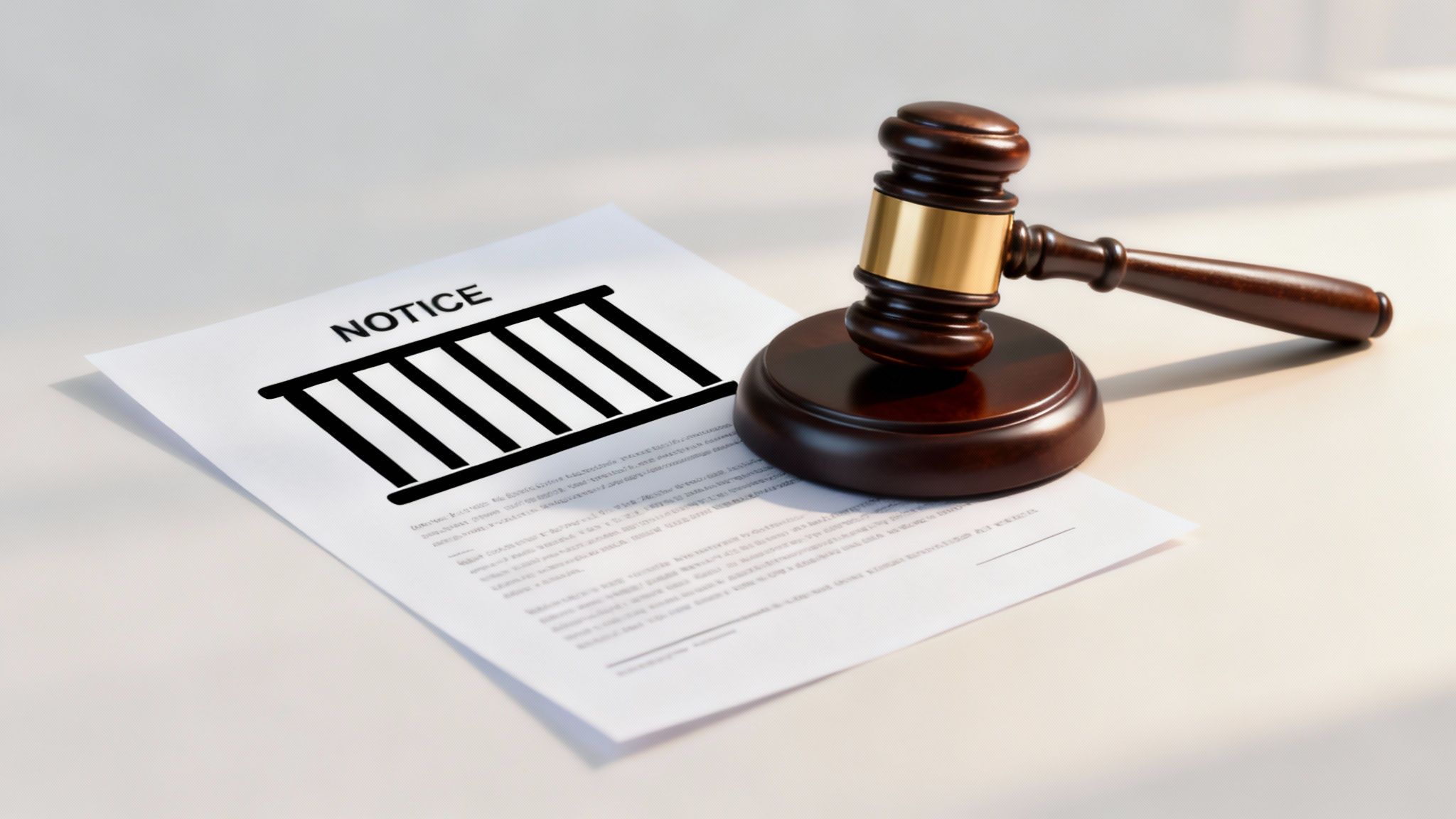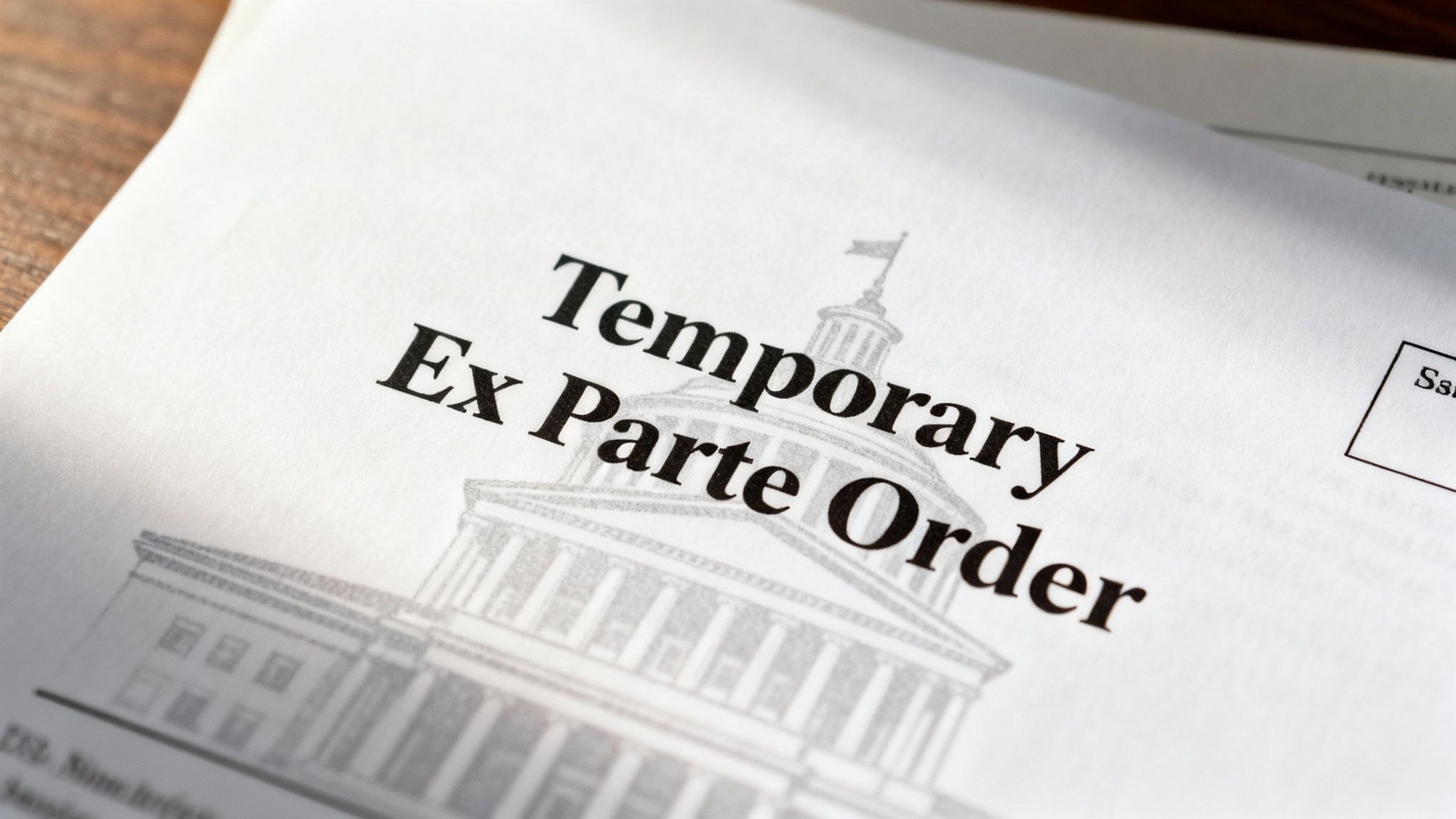Being accused of violating a protective order in Texas can be terrifying, throwing your life into a tailspin. It's not just a family court issue—it's a serious criminal charge. A first offense is typically a Class A misdemeanor, but it can quickly escalate to a third-degree felony, carrying the threat of serious prison time and crippling fines. If you've been accused of a violation, it's critical to understand the charges and your rights. You don’t have to face this alone.
Understanding a Violation of a Protective Order in Texas
When a judge issues a protective order, it creates a set of clear, legally binding rules designed to prevent family violence. These orders establish a safe distance and prohibit communication between you (the respondent) and the person who requested the order (the petitioner).
When you're accused of breaking those rules, you’re no longer just dealing with a family court matter. You are thrust into the criminal justice system. The state now believes you knowingly or intentionally ignored a judge's direct command, and prosecutors will work hard to prove it. It’s a frightening position to be in, but it’s not hopeless. A strong defense starts with understanding what, exactly, constitutes a violation.
This infographic breaks down what happens when an active order is violated and what consequences can follow.

As the visual makes clear, any prohibited contact—whether it’s direct or indirect—can trigger criminal charges. Knowing what counts as "contact" is the first step to building your defense.
What Actions Constitute a Violation
A violation isn't always a dramatic confrontation. Often, it’s something much quieter that can unintentionally land you in serious legal trouble. Under Texas Penal Code § 25.07, it’s a crime to break the specific rules laid out in your protective order. While every order is slightly different, most prohibit the same core actions.
Below is a table outlining the common behaviors that judges and prosecutors consider violations.
Common Actions That Violate a Texas Protective Order
| Type of Violation | Description | Potential Legal Consequence |
|---|---|---|
| Direct Contact | Sending texts, making phone calls, emailing, or messaging on social media. This also includes in-person communication. | Class A Misdemeanor or Felony charges, depending on the circumstances. |
| Indirect Contact | Asking a friend, family member, or coworker to pass along a message to the protected person on your behalf. | Treated the same as direct contact; can lead to immediate arrest and criminal charges. |
| Proximity Violations | Going to or near the petitioner's home, school, or workplace. The order specifies a distance, often 500 feet. | A clear violation that can be proven with GPS data, security footage, or witness testimony. |
| Threatening or Harassing | Any communication, direct or indirect, that is perceived as threatening, harassing, or intimidating. | Can escalate the charge, especially if it leads to an assault or stalking allegation. |
| Firearm Possession | Owning, possessing, or trying to purchase a firearm while the protective order is active. | This is a federal offense in addition to a state-level violation, carrying its own severe penalties. |
| Committing Violence | Any act of family violence or assault against the protected person. | This is the most serious violation and will almost certainly result in a felony charge. |
It's crucial to understand that even an action you believe is harmless, like sending a text message to apologize, is a criminal act in the eyes of the law. The court doesn't focus on your intent; it focuses on whether you broke the rules.
The Severity of the Consequences
The legal fallout from a protective order violation is swift and severe. For a first-time offense, you’re looking at a Class A misdemeanor, which is punishable by up to one year in county jail and a fine of up to $4,000.
If you have a previous violation on your record or the new violation involves an assault, the charge gets bumped up to a third-degree felony. That means you could face 2 to 10 years in a state prison. For more details on the process, this protective order fact sheet provides a helpful overview.
This is exactly why you cannot afford to take an accusation lightly. A conviction leaves a permanent stain on your criminal record, affecting your ability to get a job, find housing, and even own a firearm for the rest of your life.
Navigating the Legal Process After an Accusation
https://www.youtube.com/embed/6zBOsqPubis
An arrest for violating a protective order can make your world spin out of control. Suddenly, you're thrown into the complex Texas criminal justice system—a place with its own rules and procedures. Understanding this process is the first critical step in fighting for your future.
The journey begins the moment you are arrested. You’ll be taken to jail for booking, where you will be fingerprinted, photographed, and asked for personal information. It’s an intimidating experience, but it’s a standard part of any criminal case.
After booking, your next stop is the arraignment. This is your first official court appearance, and it's a pivotal moment in your case.
Your First Court Appearance: The Arraignment
At your arraignment, a judge will formally read the charges against you and ask you to enter a plea. At this early stage, the plea is almost always "not guilty." Pleading not guilty preserves all your legal rights and gives your attorney the necessary time to investigate the allegations.
A crucial part of the arraignment is setting bail. The judge will decide on a bail amount, which is the money required for you to be released from jail while your case proceeds. The judge considers several factors:
- The seriousness of the alleged violation.
- Your criminal history, if any.
- Your ties to the community, such as a job or family.
- Whether you are considered a flight risk or a danger to the petitioner.
An experienced criminal defense attorney can argue for a reasonable bail amount or even for your release on a personal recognizance (PR) bond, which means you wouldn't have to pay anything upfront.
The Prosecutor vs. Your Defense Attorney
Once you’re in the system, two key players will shape the outcome of your case: the prosecutor and your defense attorney. The prosecutor works for the State of Texas, and their job is to secure a conviction. They will use police reports, witness statements, and any other evidence to build their case against you.
Your defense attorney, on the other hand, has one loyalty: to you. Their job is to protect your constitutional rights, challenge the prosecutor's evidence, and build the strongest defense possible. They are your advocate, your guide, and your shield through this entire process. To get a better sense of what comes next, you can learn more about the procedural steps of criminal cases in Texas.
Discovery and Plea Negotiations
After the arraignment, your case moves into the discovery phase. This is when your attorney formally requests all the evidence the prosecutor has against you. This includes police reports, witness statements, photos, text messages—anything they plan to use in court.
Your attorney will meticulously review this evidence, looking for weaknesses, inconsistencies, or violations of your rights. This investigation often leads to plea negotiations. The prosecutor may offer a plea bargain—a deal to plead guilty to a lesser charge or for a reduced sentence. Your attorney will advise you on whether the offer is fair and help you decide if it’s in your best interest to accept it or fight the charges at trial.
It's also becoming more common for parts of this process to happen virtually. You can read up on the guidelines on remote legal proceedings to understand how this might affect your hearings.
Understanding the Penalties for a Conviction
A conviction for violating a protective order in Texas isn't just a fine or jail time. It's a life-altering event with consequences that can impact every part of your personal and professional life. The Texas Penal Code outlines a clear, escalating scale of punishments, showing just how seriously the state takes these offenses. It's crucial to understand the full scope of what you're facing.

The penalties go far beyond the courtroom. The system is designed not just to punish but to deter future violations, which is why the consequences are severe and long-lasting.
From Misdemeanor to Felony
For a first-time offense, a violation of a protective order is typically charged as a Class A Misdemeanor. Don't let the word "misdemeanor" fool you. This is the most serious type of misdemeanor in Texas.
A conviction for a Class A Misdemeanor can mean:
- Up to one year in county jail.
- A fine of up to $4,000.
- A permanent blemish on your criminal record.
However, the situation can escalate dramatically. The charge can be enhanced to a third-degree felony under certain circumstances. If you have been convicted of violating a protective order twice before, or if the current violation involves an allegation of assault or stalking, the stakes become much higher.
A third-degree felony conviction in Texas carries a potential prison sentence of two to ten years in a state facility and a fine of up to $10,000. This leap from county jail to state prison highlights the gravity of repeat offenses or violations involving violence.
Understanding these distinctions is vital. The specific facts of your case will determine whether the prosecutor pursues misdemeanor or felony charges. A strong defense is the only way to fight for a lesser charge—or a dismissal altogether.
To make this crystal clear, here’s a simple breakdown of how the penalties stack up.
Texas Penalties for Protective Order Violations at a Glance
This table shows the legal classifications and potential penalties for first-time versus repeat violations of a protective order in Texas.
| Violation Type | Criminal Classification | Maximum Jail/Prison Time | Maximum Fine |
|---|---|---|---|
| First Offense | Class A Misdemeanor | 1 Year in County Jail | $4,000 |
| Repeat Offense or Violation with Assault/Stalking | Third-Degree Felony | 10 Years in State Prison | $10,000 |
As you can see, the jump is significant. One prior conviction can be the difference between serving time locally and being sent to a state prison for years.
The Collateral Consequences of a Conviction
Jail time and fines are only the beginning. A conviction for violating a protective order creates a cascade of "collateral consequences"—hidden penalties that can impact you for years to come.
One of the most immediate impacts is on your Second Amendment rights. Under both Texas and federal law, a conviction can result in a lifetime ban on owning or possessing a firearm. This is a permanent loss of a constitutional right.
Beyond that, a conviction can severely damage other areas of your life:
- Child Custody: A family court judge will view a conviction for violating a protective order very negatively, which can devastate your custody or visitation rights.
- Employment: Many employers run background checks. A criminal record for this type of offense can make it incredibly difficult to find or keep a job, especially in fields requiring trust or a security clearance.
- Housing: Landlords often reject rental applications from individuals with criminal records, making it a serious challenge to find a place to live.
These long-term consequences are exactly why it's so important to understand the complete picture of Texas's sentencing policies and rehabilitation strategies. The goal of a strong defense isn't just to avoid jail but to protect your future from these lasting, devastating effects.
How to Build a Strong Defense Strategy
When you're accused of violating a protective order in Texas, it can feel like the walls are closing in. But an accusation is not a conviction. The prosecution has a high burden—they must prove beyond a reasonable doubt that you intentionally and knowingly violated the order.
That’s a tough standard to meet, and it’s where a skilled defense attorney can start dismantling their case. We meticulously analyze every piece of evidence, identify weak spots in the state’s argument, and build a powerful defense strategy. There are proven defenses that work, and our goal is to show you there’s a path forward.

Arguing Lack of Intent
One of the most effective defenses is showing a lack of intent. The prosecutor has to prove you meant to break the rules. If the contact was a genuine accident, it doesn't meet the legal definition of a criminal violation.
For example, imagine you’re at a large grocery store and happen to turn down the same aisle as the protected person, not realizing they were there. The moment you see them, you immediately leave. In that situation, you had no intent to make contact, which could form the basis of a strong defense.
Another common example is an accidental "butt dial" or an automated birthday message sent from an app you forgot you had. These situations are missing the "knowing" element required for a conviction, and we can present evidence to show the contact was completely inadvertent.
Challenging False Allegations
Unfortunately, protective orders are sometimes used as a weapon in contentious family disputes, such as a bitter divorce or a heated child custody battle. It is not unheard of for someone to make a false or exaggerated claim of a violation to gain leverage in court.
It is a harsh reality that some accusers have ulterior motives. Our job is to investigate the facts, uncover those motives, and expose inconsistencies in their story to protect you from a wrongful conviction.
For instance, if the accuser claims you drove by their house but their story changes, that’s a red flag. Or perhaps they have a documented history of dishonesty. We can use that to cast serious doubt on their credibility. We investigate by gathering witness statements, reviewing social media records, and finding any communication that reveals a motive to lie.
Arguing Improper Service or Mistaken Identity
A protective order is not legally binding until you have been properly served with it. This means a copy must be delivered to you in a way that strictly follows Texas law. If law enforcement cannot prove you were legally notified about the order and its specific rules, you cannot be convicted of violating it.
- Improper Service Example: What if the papers were left on your porch and blew away? Or handed to a relative who forgot to tell you? In those cases, the service might be invalid, and we would file a motion to have the case dismissed.
Mistaken identity is another real possibility. Perhaps someone who looks like you was seen near the petitioner's home, or someone else used a phone registered in your name to send a message without your knowledge. In these scenarios, we work to provide concrete evidence—like alibis, GPS data from your phone, or witness testimony—to prove it wasn't you. Building a solid defense against a violation of protective order Texas charge requires a proactive and strategic game plan.
The Protective Order Issuance Process Explained
To build a solid defense against a violation charge, you first need to understand how a protective order is issued. Many people are blindsided by these orders, especially since the process can start without them ever being in the room. Knowing how the court works gives you crucial context and helps your attorney build a much stronger strategy.

It all begins when one person, the "petitioner," files an application with the court, claiming that family violence has occurred and is likely to happen again.
The Temporary Ex Parte Order
The first, and often most shocking, step is the Temporary Ex Parte Order (TEXPO). "Ex parte" is a legal term for a hearing where only one side is present. In this case, the petitioner stands before a judge without you, the respondent, having any say. A judge can grant this order immediately if the petitioner shows evidence of a clear and present danger of family violence.
This is a critical point. A judge can issue a court order that restricts your freedom—and carries criminal penalties for a violation—before you’ve had a chance to tell your side of the story. This initial order is temporary, usually lasting for 20 days, to provide immediate safety while the court sets a date for a full hearing.
Texas courts move quickly on these. Between 2021 and 2023, 75% to 79% of all protective order applications resulted in a final order being issued. This shows a strong tendency to prioritize the alleged victim's safety, which means you are on the defensive from day one.
The Final Protective Order Hearing
Before that temporary order becomes final, the court must hold a full hearing where both sides can present their case. This is your chance to be heard. You have the right to an attorney, the right to present your own evidence, and the right to cross-examine the petitioner and their witnesses.
To grant a Final Protective Order, the judge must be convinced that family violence has occurred by a "preponderance of the evidence," which means it’s more likely than not that the claims are true. A Final Protective Order can last for up to two years, and in some situations, even longer.
Understanding this two-step process is vital. Many individuals facing a violation of protective order Texas charge didn't even know a temporary order existed until it was too late. Knowing the legal standard for both orders is key to building an effective defense.
Many of these orders arise during broader family law matters, like messy divorces or custody disputes. A good lawyer knows how these legal issues intersect and can use that knowledge to your advantage.
Our firm provides dedicated legal support for clients navigating the complexities of Texas protective orders. We can help you understand the allegations, prepare for your hearing, and ensure your rights are protected every step of the way.
Frequently Asked Questions About Texas Protective Orders
When you're facing a charge as serious as a violation of protective order in Texas, you need clear, direct answers. This section tackles some of the most urgent questions we hear from clients in your exact situation.
Can I Go to Jail for an Accidental Text Message?
This is one of the most common fears, and the answer hinges on one key legal concept: intent. To secure a conviction, a prosecutor must prove beyond a reasonable doubt that you knowingly and intentionally violated the order.
An accidental "butt dial" or an automated calendar invite sent by your phone isn't a conscious choice to make contact. While it can still trigger an arrest, it provides your attorney with a solid foundation for a defense. The argument is simple: because there was no intent to reach out, no crime was committed under Texas law.
What Should I Do if the Protected Person Contacts Me First?
This is a dangerous situation where it’s easy to make a critical mistake. Even if the petitioner—the person with the order against you—is the one who reaches out, the protective order is a command from a judge directed at you. It places zero legal restrictions on them.
If they text, call, or message you, your legal duty is clear: do not respond. Replying in any way, even to say "please stop contacting me," can be used against you as a violation.
Here’s your practical advice:
- Do not reply to any text, email, or social media message.
- Do not answer any phone calls from their number.
- Immediately save and document everything. Take screenshots of messages and save voicemails. This is your evidence.
- Contact your criminal defense attorney right away to report what happened.
This evidence is invaluable. It helps establish a pattern of behavior from the petitioner that can be crucial to your case, especially if you’re later falsely accused of initiating contact.
How Can a Violation Affect My Permanent Record?
A conviction for violating a protective order creates a permanent criminal record that can haunt you for life. It can shut the door on job opportunities, make it difficult to find housing, and even prevent you from volunteering at your child’s school.
But there is good news: Texas law offers ways to clear your record, but your options depend entirely on the outcome of your case.
If your case is dismissed, or if a jury finds you not guilty, you may be eligible for an expunction. An expunction is a legal process that completely destroys all records of your arrest and the charge. For all practical purposes, it’s as if it never happened.
If you receive deferred adjudication probation, you might later be eligible for an order of nondisclosure, often called "record sealing." This doesn't destroy the record, but it seals it from the public, meaning most private employers and landlords won't see it during a background check.
The best way to protect your permanent record is to fight the charge aggressively from the very beginning. A dismissal or an acquittal opens the door to a full expunction—the gold standard for protecting your future.
If you’ve been charged with a crime in Texas, call The Law Office of Bryan Fagan, PLLC for a free and confidential consultation. Our defense team is ready to protect your rights.

